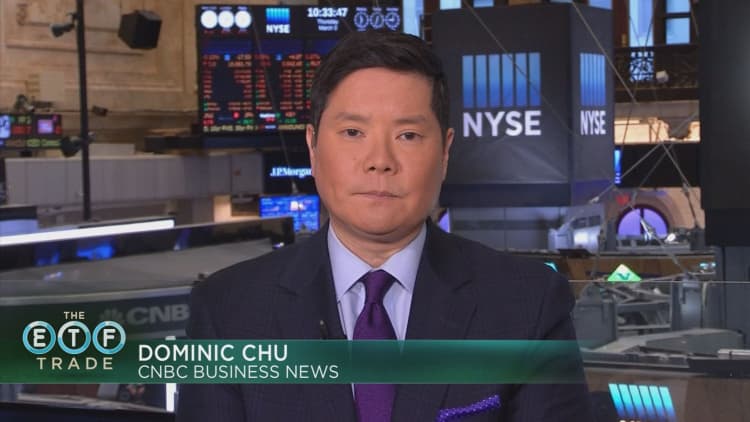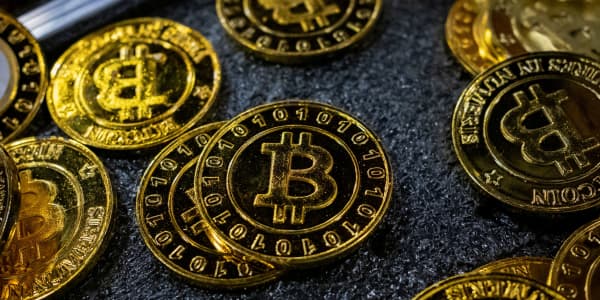Panicking over volatile equity markets, investors have poured roughly $7.5 billion into precious metals exchange-traded funds (ETFs) year-to-date, mostly chasing the gold trade.
The SPDR Gold Shares (GLD) ETF is up more than 16 percent and has taken in 77 percent of the money, or $5.6 billion. The iShares Gold Trust (IAU) ETF has seen inflows of $1.5 billion, according to XTF.com.
After such a long downturn in gold, the rebound has been remarkable, said Matt Hougan, chief executive officer of Inside ETFs. "For the sector to turn around in such a short period of time and lead all ETFs, it's pretty incredible," he said.
The gold action has also led to a less-remarkable market call: Before it's too late, sell gold as fast as you can. In the past week, the GLD trade has run out of steam, slightly negative in asset flows, according to XTF.com data, but one-week flows data — especially after a one-month haul of $3 billion — is a poor trend indicator. Over the past 10 years, however, GLD has outperformed the S&P 500 index, 7.87 percent, on an annualized basis, versus 6.84 percent for the stock index.
Investors, not traders, need to think twice about that panicky reaction.
A trader this week told CNBC that the gold chart looked eerily like the 1999 chart — it rallied sharply and then tanked — so it's time to take profits.
One doesn't need to be a technical trader to fear that another great gold unwind is right around the corner. Gold has a history of being an all-or-nothing trade. And if you think the $7.5 billion in gold ETFs have nabbed this year is a sign that the trade has to take a turn for the worse, consider 2011.
On August 22, 2011, GLD surpassed the SPDR S&P 500 Trust ETF (SPY) as the largest ETF in the world, with more than $77 billion in assets, Hougan noted. That run-up resulted in an overaccumulation of ETF assets in precious metals.
"By the end of 2011, the sector had experienced 'the great gold unwind,'" said Tyler Mordy, president and chief investment officer of Toronto-based Forstrong Global. A long decent in commodities and massive flows out of gold ETFs followed. From 2012 to 2015, GLD had outflows of $39 billion. GLD is now at roughly $31 billion in assets.
But Hougan noted that gold had been in a bull market for a decade, until the tide turned in 2012. So is one "remarkable" quarter of inflows enough to signal to investors that another great gold unwind is coming?
If you think of gold as an all-or-nothing trade, a "safe haven" replacements for equities and even bonds when markets are volatile, there's a big risk to sticking with the precious metal for too long.
Ben Johnson, director of global ETF research at Morningstar, noted that when the economy rebounded from 2012 through 2015, "investors who stayed hunkered down in gold likely missed the rally in the equity markets and the ongoing rally in the fixed-income markets as well."

Investors are turning toward defensive positions, and gold is currently the No. 1 defensive position, along with utilities and long-term bonds.
"Gold and gold-backed ETFs have come into favor pretty rapidly since the start of the year, as investors have grappled with market volatility and concerns about geopolitical risk," said Dave Mazza, head of ETF and mutual fund research at State Street Global Advisors, sponsor of GLD. "With the political season ramping up and the underperformance of stocks and bonds, investors have flowed toward gold-backed ETFs to help them manage this difficult time period," he said.
Mazza said investors should consider looking beyond a short-term gold trade. "It's human nature to ignore diversification until it matters most, and what we are seeing is that when you have volatility reemerge, it's important to have assets that perform differently than traditional stocks and bonds," he said.
Precious metals — and gold, in particular — typically have lower correlations to the stock and bond markets than many other commodities, such as oil. Part of the reason is that supply-and-demand characteristics for gold are different. "With oil, much of it is driven by economic growth and is one of the main reasons oil is struggling," Mazza said. But gold has technological uses and is a large part of the jewelry demand. Central banks are also buyers of gold.
"There are all these different forces at play — some of them are more are procyclical to gold and some are countercyclical to gold — so it gives gold a different risk-and-return characteristic than other commodities or other assets more broadly," Mazza said.
It's human nature to ignore diversification until it matters most.Dave Mazzahead of ETF and mutual fund research at State Street Global Advisors
Gold's "fatal flaw" in the thinking of many investors is that it offers no income. But that may not be as big a negative as historically in a market obsessed with negative interest rates around the world.
"People want income wherever they can get it," Mordy said. But, he added, "now that we are getting negative interest-rate policies around the world, that is pushing people into gold."
The barrier to entry for gold has been that it offers no yield, but now that other, typically income-producing products are also offering low or no yield, gold is looking more attractive to those investors, Mazza said.
The stock market has settled down, and if that continues, there may be more muted flows into gold ETFs, Mazza said.
Wednesday's Fed statement could also influence the short-term trading pattern for gold, and shares of GLD spiked after the Fed decision.
Other headline risks remain.
"The political season has become rhetoric-based now, which is weighing on investors' minds, as are the issues affecting the Middle East, the migrant crisis in Europe," Mazza said. "When you have greater headline risk and uncertainty in the market, that is when you tend to see gold perform well," he said.
"The fear trade, sparked by rising market volatility and sentiment around the candidacy of Donald Trump," is back, Hougan said.
Mordy isn't convinced that's enough to stay in gold, and while he said gold is still on his firm's radar, commodities in general are oversupplied and there is better money to make in other assets. His firm made its money in gold in the past, he said.
— By Leslie Kramer, special to CNBC.com






